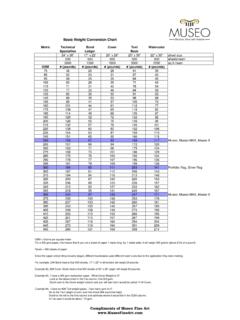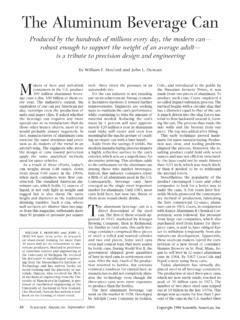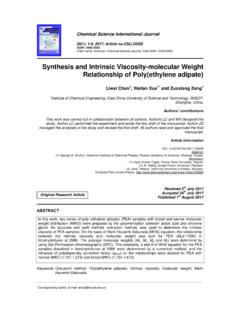Transcription of ABSTRACT arXiv:1409.1556v6 [cs.CV] 10 Apr 2015
1 [ ] 10 Apr 2015 Published as a conference paper at ICLR 2015 VERYDEEPCONVOLUTIONALNETWORKSFORLARGE-SC ALEIMAGERECOGNITIONK aren Simonyan & Andrew Zisserman+Visual Geometry Group, Department of Engineering Science,University of this work we investigate the effect of the convolutional network depth on itsaccuracy in the large-scale image recognition setting. Ourmain contribution isa thorough evaluation of networks of increasing depth usingan architecture withvery small (3 3) convolution filters, which shows that a significant improvementon the prior-art configurations can be achieved by pushing the depth to 16 19weight layers.
2 These findings were the basis of our ImageNet Challenge 2014submission, where our team secured the first and the second places in the localisa-tion and classification tracks respectively. We also show that our representationsgeneralise well to other datasets, where they achieve state-of-the-art results. Wehave made our two best-performing ConvNet models publicly available to facili-tate further research on the use of deep visual representations in computer networks (ConvNets) have recently enjoyed agreat success in large-scale im-age and video recognition (Krizhevsky et al., 2012; Zeiler &Fergus, 2013; Sermanet et al.)
3 , 2014;Simonyan & Zisserman, 2014) which has become possible due tothe large public image reposito-ries, such as ImageNet (Deng et al., 2009), and high-performance computing systems, such as GPUsor large-scale distributed clusters (Dean et al., 2012). Inparticular, an important role in the advanceof deep visual recognition architectures has been played bythe ImageNet Large-Scale Visual Recog-nition Challenge (ILSVRC) (Russakovsky et al., 2014), which has served as a testbed for a fewgenerations of large-scale image classification systems, from high-dimensional shallow feature en-codings (Perronnin et al., 2010) (the winner of ILSVRC-2011) to deep ConvNets (Krizhevsky et al.
4 ,2012) (the winner of ILSVRC-2012).With ConvNets becoming more of a commodity in the computer vision field, a number of at-tempts have been made to improve the original architecture of Krizhevsky et al. (2012) in abid to achieve better accuracy. For instance, the best-performing submissions to the ILSVRC-2013 (Zeiler & Fergus, 2013; Sermanet et al., 2014) utilisedsmaller receptive window size andsmaller stride of the first convolutional layer. Another line of improvements dealt with trainingand testing the networks densely over the whole image and over multiple scales (Sermanet et al.
5 ,2014; Howard, 2014). In this paper, we address another important aspect of ConvNet architecturedesign its depth. To this end, we fix other parameters of the architecture, and steadily increase thedepth of the network by adding more convolutional layers, which is feasible due to the use of verysmall (3 3) convolution filters in all a result, we come up with significantly more accurate ConvNet architectures, which not onlyachieve the state-of-the-art accuracy on ILSVRC classification and localisation tasks, but are alsoapplicable to other image recognition datasets, where theyachieve excellent performance even whenused as a part of a relatively simple pipelines ( deep features classified by a linear SVM withoutfine-tuning).
6 We have released our two best-performing models1to facilitate further rest of the paper is organised as follows. In Sect. 2, we describe our ConvNet details of the image classification training and evaluation are then presented in Sect. 3, and the current affiliation: Google DeepMind+current affiliation: University of Oxford and Google DeepMind1 vgg/research/very_deep/1 Published as a conference paper at ICLR 2015configurations are compared on the ILSVRC classification task in Sect. 4. Sect. 5 concludes thepaper. For completeness, we also describe and assess our ILSVRC-2014 object localisation systemin Appendix A, and discuss the generalisation of very deep features to other datasets in Appendix , Appendix C contains the list of major paper measure the improvement brought by the increased ConvNetdepth in a fair setting, all ourConvNet layer configurations are designed using the same principles, inspired by Ciresan et al.
7 (2011); Krizhevsky et al. (2012). In this section, we first describe a generic layout of our ConvNetconfigurations (Sect. ) and then detail the specific configurations used in the evaluation (Sect. ).Our design choices are then discussed and compared to the prior art in Sect. training, the input to our ConvNets is a fixed-size224 224 RGB image. The only pre-processing we do is subtracting the mean RGB value, computedon the training set, from each image is passed through a stack of convolutional (conv.)layers, where we use filters with a verysmall receptive field:3 3(which is the smallest size to capture the notion of left/right, up/down,center).
8 In one of the configurations we also utilise1 1convolution filters, which can be seen asa linear transformation of the input channels (followed by non-linearity). The convolution stride isfixed to1pixel; the spatial padding of conv. layer input is such that the spatial resolution is preservedafter convolution, the padding is1pixel for3 3conv. layers. Spatial pooling is carried out byfive max-pooling layers, which follow some of the conv. layers (not all the conv. layers are followedby max-pooling). Max-pooling is performed over a2 2pixel window, with stack of convolutional layers (which has a different depthin different architectures) is followed bythree Fully-Connected (FC) layers: the first two have 4096 channels each, the third performs 1000-way ILSVRC classification and thus contains 1000 channels (one for each class).
9 The final layer isthe soft-max layer. The configuration of the fully connectedlayers is the same in all hidden layers are equipped with the rectification (ReLU (Krizhevsky et al., 2012)) note that none of our networks (except for one) contain Local Response Normalisation(LRN) normalisation (Krizhevsky et al., 2012): as will be shown in Sect. 4, such normalisationdoes not improve the performance on the ILSVRC dataset, but leads to increased memory con-sumption and computation time. Where applicable, the parameters for the LRN layer are thoseof (Krizhevsky et al., 2012). ConvNet configurations, evaluated in this paper, are outlined in Table 1, one per column.
10 Inthe following we will refer to the nets by their names (A E). All configurations follow the genericdesign presented in Sect. , and differ only in the depth: from 11 weight layers in the network A(8 conv. and 3 FC layers) to 19 weight layers in the network E (16 conv. and 3 FC layers). The widthof conv. layers (the number of channels) is rather small, starting from64in the first layer and thenincreasing by a factor of2after each max-pooling layer, until it Table 2 we report the number of parameters for each configuration. In spite of a large depth, thenumber of weights in our nets is not greater than the number ofweights in a more shallow net withlarger conv.
![arXiv:0706.3639v1 [cs.AI] 25 Jun 2007](/cache/preview/4/1/3/9/3/1/4/b/thumb-4139314b93ef86b7b4c2d05ebcc88e46.jpg)

![arXiv:1301.3781v3 [cs.CL] 7 Sep 2013](/cache/preview/4/d/5/0/4/3/4/0/thumb-4d504340120163c0bdf3f4678d8d217f.jpg)
![@google.com arXiv:1609.03499v2 [cs.SD] 19 Sep 2016](/cache/preview/c/3/4/9/4/6/9/b/thumb-c349469b499107d21e221f2ac908f8b2.jpg)













